|
The VK45.02(P) tank was Professor Porsche’s attempt to create a tank design for production after losing the contest to
produce the Tiger I and effectively represents his version of the Tiger II. Since this tank probably only ever existed on the drawing board any model kit belongs
in a German armour modellers ‘concept collection’ set of AFVs.
Two kits of this vehicle have been released by Friendship Models under their ‘Wee Vehicles’ label and this preview covers both: the
complete model kit (WV7201) and a conversion kit (WVC7216) of the same vehicle using parts from the DML Ferdinand or Elefant (kit nos. 7201 and 7202).
The only difference between the conversion set and the complete kit is the provision of the running gear consisting of tracks,
sprockets, idlers, road wheels and suspension units (seen in the right of Figure 1). If you have a spare DML kit ‘gathering dust’ then the conversion set may be the
better option otherwise the complete kit provides everything you’ll need to build the vehicle. This review will cover the conversion set components
first, followed by the additional parts in the full kit.
WVC7216
The ‘Wee Vehicles’ offering comes well wrapped and individually bagged in a small sturdy plain white cardboard box but with no instruction sheets. The box is
indispensable since some of the parts contain very delicate detail and small parts, whilst the lack of instruction sheet is not critical since it
should be quite obvious which parts fit where.
The kit should be straightforward to assemble and consists of the hull, turret and two gun/cradle extension tubes made of resin. White metal parts
complete the kit and consist of two gun barrels, two turret hatches, muzzle brake, two sets of spare track links, a 20-tonne jack, four tow shackles,
two headlights, hull machine gun and drivers vision port armoured cover.
Ian Hanratty of Friendship Models explained that the reason for including two gun barrels was due to his concerns over being able to cast a one piece
barrel complete with muzzle brake. Later releases of the kit may therefore only contain one version of the barrel and muzzle brake and relevant gun/cradle
extension tube.
The hull and turret are probably two of the best resin moulded parts I have seen and are reminiscent of the quality from MR Modelbau resin kits. Admittedly
the turret is based on the DML ‘Porsche’ Tiger II turret (DML kit no. 7231), whilst the lower half of the hull is based on the DML Ferdinand or Elefant kit.
There is virtually no flash on the parts and only small remnants of moulding pour plugs on each part, though these have been conveniently placed so as not
to potentially ruin any detail on the visible surfaces. Any effort required in ‘cleaning up’ these parts ready for assembly and painting should therefore
be minimal.
Moreover the detail present on the surfaces is impressive. For example the three turret lifting lugs are fully moulded and do not look like they are about
to drop off, whilst inspection hatch handles on the upper engine decking are so fine they actually look in scale. Vehicle stowage, consisting of tow ropes
and barrel cleaning rods are moulded in situ on the upper hull sides. Most modellers would normally prefer these to be separate, but in this case the items
are beautifully undercut thereby avoiding the nasty ‘moulded on’ look. The rear engine decking is nicely done; whilst any super-detailer may wish to add
replacement etched brass grilles over the air intakes, they will also look good left unmodified with just a heavy dark wash when painted.
Detail on the underside of the hull is as per the DML Ferdinand/Elefant kit. One minor point here is that the original plans [Ref. 4] do not show the
additional ‘bolt on’ front armour belly plate as being fitted and which was only added when the VK45.01(P) hulls were converted into Ferdinands and
Elefants. Whilst it is possible that this modification would have found its way onto any VK45.02(P) there is nothing to indicate it did, so it is up
to the individual whether they think it should be present or not.
A further point concerns track guards, shown on the plan view of the vehicle in [Ref. 4] but neither of the side elevations in [Ref. 2] or [Ref. 4].
The model does not contain any and is none the worse for it, but since the VK45.01(P), Ferdinand and Elefant all had them fitted it might be assumed
that on the balance of probability the VK45.02(P) would have had them too. If the modeller wishes to add these it might be possible to modify a set
of etched brass versions intended for the Ferdinand/Elefant or at worst scratch build them.
The master model for the mould was created by Calum Melrose [Ref. 1] who based the conversion on the plan in the Tiger II New Vanguard publication [Ref. 2].
Using a copy of the original concept drawing printed in [Ref. 4] on which the plan in the Vanguard publication is based, the basic dimensions scale out as
follows (values in millimeters, those in brackets are 1/72 scaled plan dimensions):
Hull - Length: 92.8 (95.5), Height 18.8 (19.8), Width 42.6 (43.2). Turret - Length: 51.4 (51.0), Height 15.4 (16.1), Width 33.6 (34.1).
Overall the hull
and turret might be marginally under scale, but nothing to be too concerned about.
The metal parts for the hull and turret are equally as good as the resin ones. Whilst purists may want to substitute a turned aluminium barrel, the white
metal version with integral muzzle brake supplied in the kit is almost as good. Unfortunately as this is a resin kit a moveable gun barrel is not possible.
Also, due to the method of construction a rotatable turret is also not an immediate possibility, though using a small circular disc magnet glued to both
parts would be one solution to this problem.
Both commanders and loaders hatches are supplied as separate white metal parts permitting the tank to be crewed. One minor point of note here is that the
loaders hatch appears to be of a type seen on the later productions series (Henschel) Tiger II turrets and not the early test series (Porsche) turrets, nor
does it have any internal detail so if it is portrayed in the open position some additional detailing may be required.
A drivers vision port armoured cover is supplied in white metal, though I have been informed that this may appear as part of the resin hull if/when the
master model is reworked. Two front headlights are also included for addition to the front glacis plate. A complete MG34 is included with the idea that
it can be cut down and used as the hull MG. Four tow shackles are provided but unfortunately the rear lugs that accept two of these, and shown on the
plans, have not made it onto the rear hull and will need to be added.
Spare track links and a nice 20-tonne jack are also provided as additional stowage items. It’s up to the individual whether they want to add more such as
fire extinguisher, jack block, spade, axe, wire cutters etc. [Ref. 3] has examples of what was added to the prototype VK45.01(P) vehicles that were this
vehicles immediate predecessors.
WV7201
The complete vehicle contains all those parts described above in the conversion set as well as the running gear described here. Assembly should be
straightforward and not much different to that for the DML Ferdinand/Elefant kit except for the fact that these parts are all cast in white metal
rather than plastic. The lack of any instruction sheet should not be a problem here either since reference can be made to the DML Ferdinand/Elefant
kit if necessary.
Like the resin and metal parts for the hull and turret these white metal parts are some of the best I’ve seen. Since they appear to be direct copies
of the DML Ferdinand/ Elefant parts this might be expected, but significantly none of the detail has been lost in the process. There is a small amount
of flash evident on most parts but essentially all the features of the plastic parts are present here right down to the small screw heads on the idler
and sprocket wheels. ‘Cleaning up’ these parts ready for assembly and painting should actually be less of a headache than their plastic counterparts.
The road wheel diameters (9.75 mm) scale out accurately to the real vehicle size of 700 mm, as do the sprockets/idlers (10.2mm) to the full scale size
of 730 mm [Ref. 3].
The white metal tracks come in ten short sections in a simplified version of ‘link and length’ and are most likely based on the hard plastic L&L tracks
from the DML Sd.Kfz. 181 PzKpfw. VI (P) kit (DR7209) that represent the Kgs 62/640/130 tracks used on the Ferdinand/Elefant tank destroyers. The detail
is therefore better than the vinyl or DS plastic tracks present in the DML Ferdinand and Elefant kits and is one very good reason to opt for the complete
‘Wee Vehicle’ kit rather than the conversion. Perhaps it would be worth Friendship Models selling the tracks on their own to replace the vinyl ‘rubber bands’
in the earlier DML kits? At an average width of 9.1 mm these scale out a fraction over size for the 640 mm (8.9 mm scale size) of the real vehicle [Ref. 3].
Note that the lengths of tracks are not all the same: seven are identical (30 links), two are slightly shorter (29 links) and one is shorter still (25 links).
In total the track sections represent 293 links. The actual vehicle would have had 109 links per side or 218 in total so there is possibly some extra track
provided. Building the model will reveal if this is the case.
In summary, both conversion set and full kit are excellently moulded and detailed examples of this conceptual vehicle. Basic accuracy appears to be good and
a straight forward build could provide an interesting companion to either a Porsche VK45.01(P) or Henschel VK45.03(H) vehicle. Some additional effort could
be useful in adding/improving minor features on the kit. Other parts such as track guards and engine grilles could be also added if you are into
super-detailing kits.
References:
[1] http://www.flickr.com/photos/calummelrose/sets/72157626586296584/
[2] Jentz, T.L. & Doyle, H.L., “King Tiger Heavy Tank 1942-45”. Osprey Publishing (1993); ISBN: 185532282X
[3] Jentz, T.L. & Doyle, H.L., “Panzerkampfwagen VI P (Sd.Kfz.181) - A History of the Porsche type 100 and 101, also known as the LEOPARD and TIGER (P)”. Schiffer Publishing Ltd. (1997); ISBN: 0-7643-0224-8
[4] Jentz, T.L. & Doyle, H.L., “Panzerkampfwagen VI P (Sd.Kfz.181) - A History of the Porsche type 100 and 101, also known as the LEOPARD and TIGER (P)”. Darlington Publications Inc. (1997); ISBN: 1-892848-03-01
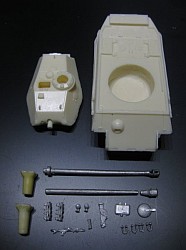
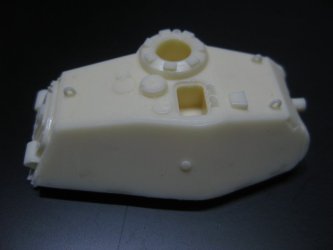

Parts found in WVC7216 & WV7201
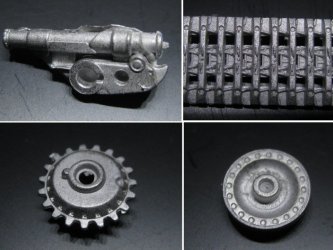
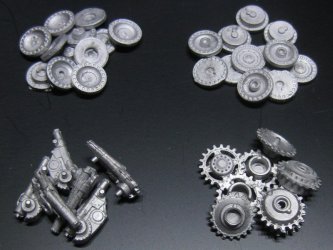
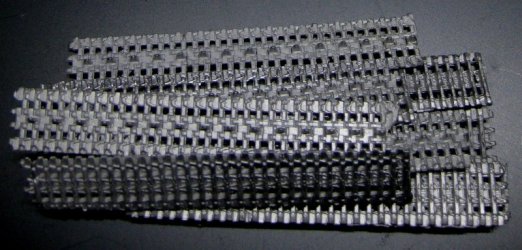
Additional suspension & track parts found in WV7201
|